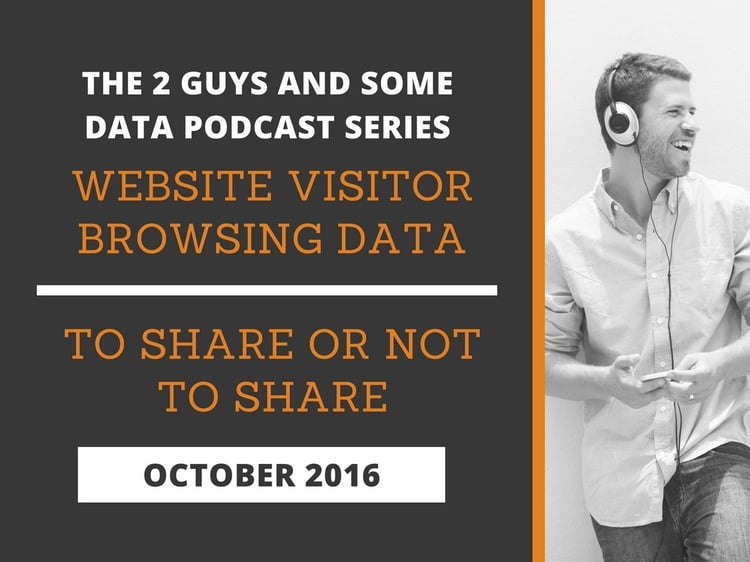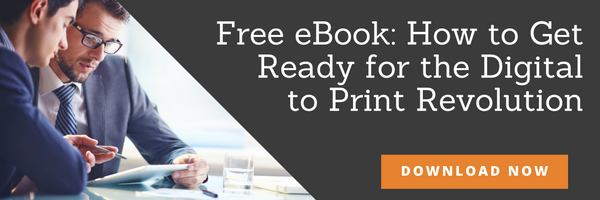Podcast — Website Visitor Browsing Data: To Share or Not to Share


Sharing transactional data with database co-ops has been commonplace for years, but as new technologies emerge and businesses are able to gain insights into anonymous browser behaviors, a new debate has opened. Should you share your website browsing behavior or not?
(Podcast Transcript)
Allen: Hey, everyone. How are all you data-driven marketers out there today? If you're looking for new ways to reach unique prospects, and better engage your audiences, well you're in the right place. This is a second podcast for the 2 Guys and Some Data series, we're giving you some nitty gritty advice you actually need to make more money. I'm Allen Abbott.
Larry: And I'm Larry Kavanagh.
Allen: And today we're talking about the great debate, surrounding the sharing of visitor browsing behavior. Before you say, "What? That's a great debate? I'm not interested." Hear us out. There are some very important things to think about before you make what is a very critical decision about your own data, and we want to fill you in.
Larry: So Allen, what's the big deal with website visitor data? I mean, only 2% to 5% of the people who visit my website, actually buy. Why do I care about those useless other people who didn't deign to buy my product?

Allen: It's certainly true that only 2% to 5% buy. We also tend to get information about some others, maybe another 10% who will give an email address, or somehow we can match them, but still those other 85% who are not identifiable, we can now identify a lot of them. We can, using some emerging technology, identify probably 50% to 75% of anonymous browsers, and tell folks who they are. The combination of very detailed browsing behavior that can now be collected, along with the increased capability to identify visitors at postal addresses, provides some great clues about who is in the market for your products and what they are looking for.
So what I'd like to know though, is, so what do I do with all this visitor intent data, Larry? How do I use it?
Larry: Well, Allen as you mentioned, those 95% of people who visit and don't buy, they're telling you something. They're telling you they're on your website. They found you somewhere; whether it was a paid search, whether it was SEO, whether it was some radio advertising you did. They found you. They're interested in your company and your product. That's a very unique prospect audience. Where I think the big opportunities today is to really pay attention to what they're doing on your website, because they're not all equally interested. They're at different points in their buying, you know, in their path to purchase.
Some of them are just checking you out for the first time. They're at the top of the funnel, if you think about sort of a conversion funnel. Others are giving you a deeper dive, they're looking a little bit more deeply at what you’re doing. Others are right at the verge of being ready to buy but not quite ready to cross over. I think also, really critically, they're telling you what they're interested in ― what products they're interested in, what price points they're interested in. They're even giving you clues about what marketing messages they respond to. This is all great data you can use to sort of convert that knowable 95% of people who visit your website and don't buy. All great data to help you convert them more effectively.
Allen: Okay, so, for example, let's say our colleague Chris is looking for new speakers for his production studio, where he makes music at his house. Early in his search, we might send him an email with a short white paper talking about what's new in speaker technology? Is that right?
Larry: Absolutely. I think you're right on. You've got to match where someone is in their path to purchase. The opportunity is to match the advertising medium to where they are in that path. When they're just at the very top? Frankly, you don't want to use a very expensive medium. Because they're really just sort of learning and trying to figure it out. Digital marketing is great for that. As they get closer to the bottom of the funnel, the opportunity frankly is to use more direct response type medium — media that really sort of breaks through the clutter and gets your message in front of them.
Allen: Okay, so when he gets more interested, and we understand based on his behavior that he's getting closer to a buying decision, we could then send him a postcard, say, with an offer for sound equipment. To help close the deal.
Larry: Absolutely. There's a lot of different possibilities that you can do with that. You know what, Allen, there's a lot of folks today who are...this whole concept of using digital browsing data across a variety of medium, direct mail, addressable TV, etc. is really exploding. But I see a lot of companies that are offering these kind of services require that if you're going to participate that you share your data with them in some type of co-op fashion. What do you think about that? People are already sharing data. Lots of people are sharing data with 4 or more transactional co-ops. Should we share this kind of data with the new, emerging browsing companies?
Allen: Well, let's think about where we are today. 25 years ago, the database cooperatives convinced a large number of people, including me, to share their transaction history, promising in return, that they would find look-alike prospects in the overall monster database. They delivered on that promise. We, as an industry, got sucked into that methodology and that model, and where we are today is that everyone is working off the same transactional data. And whatever message you're sending out there, to your prospects and your customers, it's likely that your competitors are sending similar messages to the same folks.
One of the questions you really have to ask yourself is, “if I keep this data to myself, will I beat my competitor to the mailbox?” If I have it, and I don't share it, it might be an opportunity for me to get out there ahead of the curve, and get people in there…make that buying decision before the competitors even get a chance to throw an offer at them.

Larry: In today's digital world, I think it's even broader than reaching a mailbox. Although, that's a great example. If you think about the DMPs, like Lotame, that are out there today that allow you to...they're providing all these audiences that you can push digital advertising to. You'll see audiences like, golf enthusiasts, people in the market to buy cars. Where do you think the data for that comes from? If you are sharing your browsing data into some companies that are helping you then monetize that browsing data...if you're sharing that with them, thinking that it's only going to, they're only helping you advertise your product, but you're allowing them to remarket it. Believe me, those DMPs get that data out into the audiences that your competitors can buy fast. I hear DMPs today, talking about within 4 hours of receiving a data feed, that shows an audience that's interested in a particular category of product, they're promising you can have digital ads to that person that fast.
If you're sharing that browsing data, you're most likely, not only with your competitor beat you to the mailbox, but your competitor is likely going to beat you to the digital display ad.
Allen: Larry, can you just clarify for me, what's a DMP?
Larry: A DMP. Data management platform. There's a number of them out there, Lotame is one, that's really hot today. It's a very great platform. They have created these digital audiences that are partitioned of course by demographics, but also partitioned by what people buy, what they're interested in. You can essentially rent, hey I'd like to do digital ads to people who are known golf enthusiasts and have your digital ad track them all over the internet. Like I say, the speed with which they take data from data providers, and put that online is amazingly fast today.
Allen: That's all really interesting and a little bit scary. Is there any research out there to help people make this really hard decision?
Larry: Not that I'm aware of. This whole thing is a very new field. Only the last couple of years has it even been possible to really do this. To me, the way I would think about it is, think about what it would cost you to share this data. Take a look at how many web transactions occur on your website that come from first time visitors, when someone first visits, and that come from people who come back and revisit. If you've got 70% of your transactions coming from people who don't buy on the first visit, but buy on a second, third or fourth visit, if you're sharing that data you're putting that 70% of transactions at risk. Because, as you pointed out Allen, you're the only one who knows that visitor's on your site unless you share it.
If you get 100% of transactions on first visit, share the data all day, doesn't matter. But if you're like most people, and shoppers come and visit your website and check you out a little bit before they make a purchase, you're really putting a large portion of your, frankly, online revenue at risk.
Allen: Okay, that's very helpful. I will add though that we have heard from clients that when they don't share the data, and they put that audience out there, there is very little overlap with audiences that they're getting from other providers, so what you're saying makes great sense.
Larry: Allen, so you've been in this industry for a long time. You saw the rise of the original data co-ops through today's world. What do you think the wisest course of action is here for companies?

Allen: Part of me, the old direct marketer in me, you know, test and learn, would say, "Okay, let's be careful about the questions we ask these providers who are asking us to share data, and make as informed a decision as we possibly can." I'm going to be a little more direct, and just say, “no, don't share it.” We're very early in this experiment. It's rather new. There's more that we don't know, than what we do know, but we do know there's a lot of things you can do with your own data without sharing the data with others. My suggestion would be, let's exhaust those, before we go out there and start sharing this data.
Larry: Very good. Sounds like very sound advice. Thanks for listening to 2 guys ramble about data and marketing for the past few minutes. If you got what you needed, you'll probably like our blog, too. Check out more of our resources at www.navistone.com/blog, again, that's navistone.com/blog. We'll be back in a few weeks to talk about the most lucrative data out there, and how it helps you better connect with customers. Thank you very much, again, I'm Larry Kavanagh, and-
Allen: I'm Allen Abbott, and have a good day everyone.
Related Topics

Allen Abbott has a long track record and over 28 years of experience in growing successful retail and direct marketing businesses. Allen shares his deep experience and keen insights in the areas of brand development and deployment, general business strategy, as well as strategic marketing and data solutions. While serving as CEO at Paul Fredrick MenStyle from 2000-2012, Allen oversaw a complete business turnaround and ten years of sustained sales and profit growth during his tenure with the company. Allen’s experience in retail includes executive positions at Exposures, Day Timers, and Bloomingdales. He has a strong track record in growing both top and bottom lines, and is an excellent strategic marketer, team builder and leader.





Comments